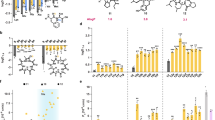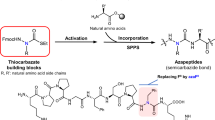Abstract
The chemistry associated with the process of N,O-acyl migration was explored in both cyclic and linear peptides under aqueous acid conditions. The importance of backbone cyclization and N-methylation of the peptide bond on the kinetics of N,O-acyl migration in a series of linear and cyclic peptides related in structure to cyclosporin A (CsA) were examined. The similarity in the chemical reactivity of the cyclic peptide [MeLeu (3-OH)]1-CsA and the corresponding linear peptide [Val-MeLeu (3-OH)-Abu], suggested that for this series, cyclization of the peptide backbone may not play an important role in controlling the kinetics of N,O-acyl migration. In contrast, the disparity in the chemical reactivity of tripeptides [Val-MeLeu (3-OH)-Abu] and [Val-Leu (3-OH)-Abu], indicated that N-methylation of amide bond significantly impacted the kinetics. Various hypothesis are proposed to account for this observation.
Similar content being viewed by others
REFERENCES
M. C. Manning, K. Patel, and R. T. Borchardt. Stability of protein pharmaceuticals. Pharm. Res. 6:903–918 (1989).
R. Oliyai and V. J. Stella. Kinetics and mechanism of isomerization of cyclosporin A. Pharm. Res. 9:617–622 (1992).
R. Oliyai, M. Safadi, P. G. Meier, M.-K. Hu, D. H. Rich, and V. J. Stella. Kinetics of acid-catalyzed degradation of cyclosporin A and its analogs in aqueous solution. Int. J. Peptide & Protein Res. 43:239–247 (1994).
D. H. Rich, M. K. Dhaon, B. Dunlap and P. F. Miller. Synthesis and antimitogenic activities of four analogues of cyclosporin A modified in the 1-position. J. Med. Chem. 29:978–984 (1986).
J. R. McDermott and M. L. Benoiton. N-methylamino acids in peptide synthesis. V. The synthesis of N-tert-butyloxycarbonyl, N-methylamino acids by N-methylation. Can. J. Chem. 55:906–910 (1977).
S. Chakrabarti and T. J. Siahaan. Stability of linear and cyclic RGD peptides. Pharm. Res. 10:S93 (1993).
D. S. Egglestone, P. W. Baures, C. E. Peishoff and Kenneth D. Kopple. Conformations of cyclic heptapeptides: Crystal structure and computational studies of evolidine. J. Am. Chem. Soc. 113:4410–4416 (1991).
T. J. Siahaan, S. Chakrabarti and D. Vander Velde. Conformational study of cyclo(1,5)-Ac-Pen-Arg-Gly-Asp-Cys-NH2 in water by NMR and molecular dynamics. Biochem. Biophys. Res. Comm. 187:1042–1047 (1992).
E. S. Stevens, N. Sugawara, G. M. Bonora and C. Toniolo. Conformational analysis of linear peptides. 3. Temperature dependence of NH chemical shifts in chloroform. J. Am. Chem. Soc. 102:7048–7050 (1980).
K. Wüthrich. Modern NMR of proteins and Nucleic acids. Wiley, New York (1986).
J. D. Aebi, D. T. Deyo, C. W. Sun, D. Guillaume, B. Dunlap and D. H. Rich. Synthesis, conformation, and immunosuppressive activities of three analogues of cyclosporin A modified in the 1-position. J. Med. Chem. 33:999–1009 (1990).
R. A. Wiley and D. H. Rich. Peptidomimetics derived from natural products. Med. Res. Rev. 13:327–384 (1993).
F. Marcus. Preferential cleavage at aspartyl-prolyl peptide bonds in dilute acid. Int. J. Peptide & Protein Res. 25:542–546 (1985).
M. Landon. Cleavage at aspartyl-prolyl bonds. Methods Enzymol. 47:145–149 (1977).
V. Somayaji and R. S. Brown. Distorted amides as models for activated peptide N − C = O units produced during enzyme-catalyzed acyl transfer reactions. The mechanism of hydrolysis of 3,4-dihydro-2-oxo-1,4-ethanoquinoline and 2,3,4,5-tetrahydro-2-oxo-1,5-ethanobenzazepine. J. Org. Chem. 51:2676–2686 (1986).
V. Somayaji, K. I. Skorey, R. S. Brown and R. G. Ball. Molecular structure of 2,3,4,5-tetrahydro-2-oxo-1,5-ethanobenzazepine and its reaction with β-amino alcohols as a model for the acylation step of serine proteases. J. Org. Chem. 51:4866–4872 (1986).
J. W. Keillor and R. S. Brown. Attack of zwitterionic ammonium thiolates on a distorted anilide as a model for the acylation of papin by amides. A simple demonstration of a bell-shaped pH/rate profile. J. Am. Chem. Soc. 114:7983–7989 (1992).
A. J. Bennet, Q-P Wang, H. Slebocka-Tilk, V. Somayaji and R. S. Brown. Relationship between amidic distortion and ease of hydrolysis in base. If amidic resonance does not exist, then what accounts for the accelerated hydrolysis of distorted amides? J. Am. Chem. Soc. 112:6383–6385 (1990).
H. Slebocka-Tilk, A. J. Bennet, H. J. Hogg and R. S. Brown. Predominant 18O exchange accompanying base hydrolysis of a tertiary toluamide: N-ethyl-N-(trifluoroethyl)toluamide. Assessment of the factors that influence partitioning of anionic tetrahedral intermediates. J. Am. Chem. Soc. 113:1288–1294 (1991).
Author information
Authors and Affiliations
Rights and permissions
About this article
Cite this article
Oliyai, R., Siahaan, T.J. & Stella, V.J. The Importance of Structural Factors on the Rate and the Extent of N,O-acyl Migration in Cyclic and Linear Peptides. Pharm Res 12, 323–328 (1995). https://doi.org/10.1023/A:1016231913858
Issue Date:
DOI: https://doi.org/10.1023/A:1016231913858




